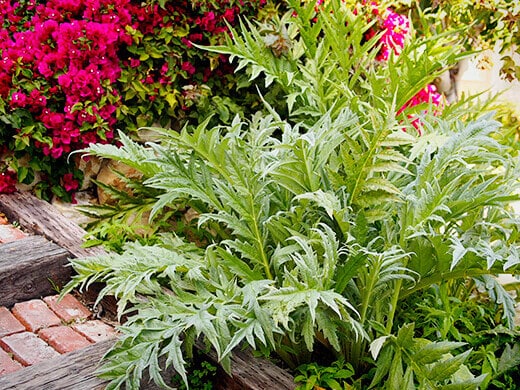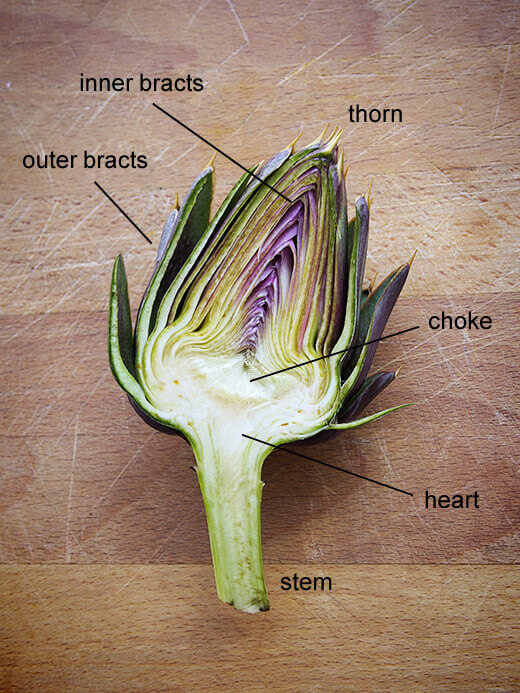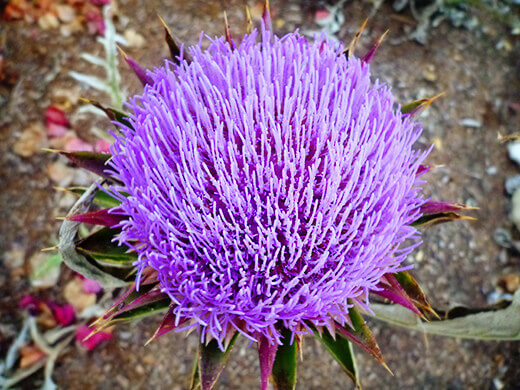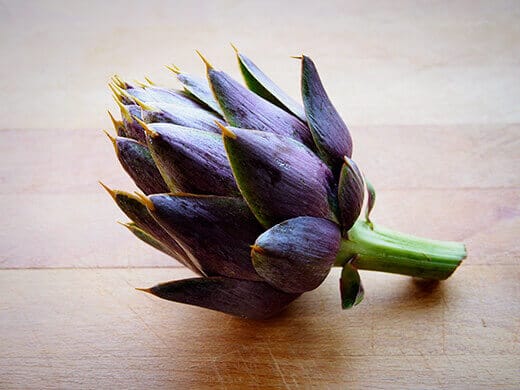Artichokes are such interesting things. We consider the artichoke (Cynara cardunculus var. scolymus) a vegetable (even a perennial vegetable in certain climates), even though it’s a thistle and more specifically, the part that we eat (and that most people ever see in the store) is actually a flower bud—and sometimes called a head.
What’s even more confusing is the fact that most recipes (including my own) call for peeling off the “leaves” of the artichoke to prepare it (for simplicity’s sake), but the real leaves are the silvery-green ones from the artichoke plant itself.

Since the part we’re eating is the flower bud, what does that make those “leaves” we’re peeling? No, not petals—but bracts, which are the scale-like structures that protect the flower. Still with me so far?

It’s fascinating to me that the edible part of an artichoke bud is so small compared to the rest of it. An artichoke is prized for its heart, the tender flesh at the base of the bud. Every time you eat an artichoke by pulling out the bracts one by one, you’re taking a little piece of the heart with it.
But you know what my favorite part of an artichoke is? I’d have to say I love the stem, and I make a point to cut as long of a stem as I can when I harvest from my plants.
Right above the heart is the choke, a crown of pointy fibers (resembling hair) that, if left to bloom, becomes the gorgeous purple florets of an artichoke flower.

The choke in a young bud is soft and sometimes edible, especially in a baby artichoke where there may be little to no choke at all.
Contrary to popular belief, a baby artichoke isn’t a younger version of your standard artichoke; it’s a smaller but fully developed bud that grows lower on the stem after the main—and larger—bud has formed.
For comparison, the choke on the left is from a young bud that is fully developed and ripe for picking. It’s at the most desirable stage to eat an artichoke.
The choke on the right is from a more mature bud. You can see how the bracts are starting to open up and the choke is more prominent with a tinge of purple. Mature buds can be eaten as well, though they require more work to remove the hairy choke.

Now that you’ve got your anatomy down, I’ll show you how to get past all those thorns, bracts, and choke fibers to get to the good stuff inside!
More Artichoke Posts:
- How to Trim an Artichoke (Or… How to Get to the Good Stuff Right Away)
- Steamed Artichoke with Pesto Crumb
- Purple of Romagna Artichokes
















I planted a green globe artichoke in my raised bed about five months ago. I live in the Los Angeles area. The plant has produced lots of delicious artichoke.
QUESTION: Some artichokes are large…and some of them are very tiny. I am not sure if the tiny ones will develop? Or, should I remove them?
Please let me know!!
I know you posted this ages ago, but I was wondering if you knew what the inner part of the stem (the tasty part that reminds me of marrow if the stem were a bone) it’s called. I’ve been calling it the marrow of the artichoke but I’m sure that’s wrong.
I see this was written a few years ago but Im having trouble finding that out too. I want to buy them to make artichoke dip.
Very educational article. Are the real silvery-green leaves edible? Can they be used in a salad or boiled or stir fried? Thank you!
I’ve actually never tried the leaves, but have eaten the first few inches of the stem just below the bud (the most tender portion). It has a wonderful artichoke flavor, and when cooked, the texture reminds me of cooked celery.
What you’re really eating is the flower bud… & other tidbits: Anatomy of an Artichoke http://t.co/qRcWYDj0mf < TY for RT! @ReallyJeannie
Learn all the proper terms for this fascinating thistle. Anatomy of an Artichoke http://t.co/6fBGiU4jjq #gardenchat #gardening
We eat the flower and call it a vegetable but it’s actually a thistle. Anatomy of an Artichoke http://t.co/L9QsfOB8yZ #gardenchat #gardening
Ditto, i will eat artichokes now! Great post, Linda. Can i grow this at zone 5?
Artichokes will grow as an annual in zone 5. If you want to keep them going year-round, you’ll have to grow them in a large container and overwinter them indoors.
Difference between a baby artichoke and a regular artichoke? Find out: Anatomy of an Artichoke http://t.co/z5zzUlsKjD #gardenchat #gardening
Thanks for that lesson! I have never eaten artichokes but they truly fascinate me. Maybe now I will give one a try.
Leaves, bracts, choke and heart – do you know the… Anatomy of an Artichoke http://t.co/55GfTGuqb0 #gardenchat #gardening
Lauren Limbert liked this on Facebook.
Fun anatomy lesson! My dad grew artichokes for 45 years (next to that fig orchard :)) and we LOVED them! Your lesson is great. I’m considering growing cardoons next year for first time. Have you tried them yet? So much enjoy your topics and depth. Thanks so much!
I’ve never tried cardoons but I’ve heard that you can cook a young artichoke stem the same way you’d cook a cardoon stem (as the flavors are very similar). Since I find the top part of the artichoke stem delicious, I’m curious to try the rest of it!
Jill Pickett liked this on Facebook.
Anatomy of an Artichoke:
Artichokes are such interesting things. We consider the artichoke (Cynara cardunculu… http://t.co/McDOaJ9YUy
Blogged on Garden Betty: Anatomy of an Artichoke http://t.co/b9TG6AosJf